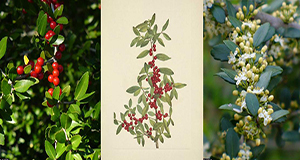Abstract
Yaupon holly, Ilex vomitoria Aiton, is an evergreen woody plant native to the southeastern United States. The species is widely used as a landscape ornamental plant because it tolerates a wide range of soil and environmental conditions, is available in various forms, and attracts wildlife, especially native birds. Recently, there has been a resurgence of interest in cultivating the plant for the caffeinated beverages that can be made from its leaves. This 8-page fact sheet written by Matthew A. Borden, Mark A. Wilhelm, and Adam G. Dale and published by the UF/IFAS Entomology and Nematology Department provides a guide to managing yaupon holly and protecting it from pests. It will be useful to both commercial growers and homeowners interested in growing this beautiful and useful plant.
https://edis.ifas.ufl.edu/in2199
References
Blackman, R. L., and V. F. Eastop. 2018. Aphids on the World's Plants: An online identification and information guide. Edited by Braman, K. S., and J. M. Ruterj. 1995. "Preference of Twolined Spittlebug for Ilex Species, Hybrids." Journal of Environmental Horticulture. 15:211-214. http://www.aphidsonworldsplants.info/ https://doi.org/10.24266/0738-2898-15.4.211
Borden, M. A., and A. G. Dale. 2020. "Native and Edible Ornamental Plant Congeners Enhance Ecosystem Services Through Key Pest Avoidance and Multifunctionality in Residential Landscapes." Environmental Entomology 49 (5): 1206-1213. https://doi.org/10.1093/ee/nvaa099
Dekle, G. W. 1965. Arthropods of Florida and Neighboring Land Areas Vol. 3: Florida armored scale insects. Florida Department of Agriculture and Consumer Services, Division of Plant Industry. https://www.fdacs.gov/ezs3download/download/25108/516024/arthropods-of-florida-vol-3.pdf
Edwards, A. L., and B. C. Bennett. 2005. "Diversity of Methylxanthine Content in Ilex cassine L. and Ilex vomitoria Ait: Assessing Sources of the North American Stimulant Cassina." Economic Botany 59 (3): 275-285. https://doi.org/10.1663/0013-0001(2005)059[0275:DOMCII]2.0.CO;2
Ferguson D. C. 2009. A revision of the red-brown caberine geometrids of the southeastern United States (Geometridae: Caberini). Tropical Lepidopteran Research 19 (1): 35-51. https://journals.flvc.org/troplep/article/view/90258
Gilman E. F., D. G. Watson, R. W. Klein, A. K. Koeser, D. R. Hilbert, and D. C. McLean. 2018. Ilex vomitoria: Yaupon Holly. Gainesville: University of Florida Institute of Food and Agricultural Sciences. https://edis.ifas.ufl.edu/st311
Hale, E. M. 1891. "Ilex cassine: The Aboriginal North American Tea." USDA Division of Botany Bulletin 14:1-22.
Hammett, J. E. 1992. "The Shapes of Adaptation: Historical Ecology of Anthropogenic Landscapes in the Southeastern United States." Landscape Ecology. 7:121-135. https://doi.org/10.1007/BF02418943
Hamon, A. B, and M. L. Williams. 1984. "Arthropods of Florida and Neighboring Land Areas Vol. 11: The Soft Scale Insects of Florida." Florida Department of Agriculture and Consumer Services, Division of Plant Industry. https://www.fdacs.gov/ezs3download/download/25116/516032/arthropods-of-florida-vol-11.pdf
Herms D. A. 2002. "Effects of Fertilization on Insect Resistance of Woody Ornamental Plants: Re- Assessing an Entrenched Paradigm." Environmental Entomology. 31:923-33 https://doi.org/10.1603/0046-225X-31.6.923
Hodges G., J. M. Ruter, and S. K. Braman. 2001. "Susceptibility of Ilex species, hybrids and cultivars to Florida wax scale (Ceroplastes floridensis Comstock)." Journal of Environmental Horticulture 19 (1): 32-36. https://doi.org/10.24266/0738-2898-19.1.32
Hodges, R. W. 1971. The Moths of America North of Mexico. Fascicle 21. Sphingoidea. E. W. Classey Limited and R.B.D. Publications Inc., London.
Hudson C. 1979. Black Drink: A Native American Tea. University of Georgia Press, Athens, GA. 175 pp.
Immel D. L. 2000. Plant guide for yaupon (Ilex vomitoria). USDA-Natural Resources Conservation Service, National Plant Data Center, c/o Environmental Horticulture Department, University of California, Davis, California. https://plants.usda.gov/plantguide/pdf/pg_ilvo.pdf
Jiggins C., M. Majerus, and U. Gough. 1993. Ant defence of colonies of Aphis fabae Scopoli (Hemiptera: Aphididae), against predation by ladybirds. British Journal of Entomology and Natural History, 6 (4): 129-137.
Johnson W. T., and H. H. Lyon. 1991. Insects that Feed on Trees and Shrubs. Cornell University Press, Ithaca, NY. 560 pp. 2nd ed., rev.
Landis, D. A., S. D. Wratten, and G. M. Gurr. 2000. "Habitat Management to Conserve Natural Enemies of Arthropod Pests in Agriculture." Annual Review of Entomology 45:175-201. https://doi.org/10.1146/annurev.ento.45.1.175
Lonsdale, O., and S. J. Scheffer. 2011. "Revision of Nearctic Holly Leafminers in the Genus Phytomyza (Diptera: Agromyzidae), Including Descriptions of Four New Species." Annals of the Entomological Society of America 104 (6): 1183-1206. https://academic.oup.com/aesa/article/104/6/1183/2758604 https://doi.org/10.1603/AN11008
Martin, C. O., and S. P. Mott. 1997. Yaupon (Ilex vomitoria): Section 7.5.10, U.S. Army Corps of Engineers Wildlife Resources Management Manual. Vicksburg, Mississippi. Mead, F. W. 1983. Yaupon psyllid, Gyropsylla ilicis (Ashmead). Florida Department of Agriculture and Consumer Services, Division of Plant Industry, Entomology Circular No. 247:1-2. https://www.fdacs.gov/content/download/10641/file/ent247.pdf
Mead, F. W. 2014. Citrus flatid planthopper, Metcalfa pruinosa (Say) (Insecta: Hemiptera: Flatidae). EENY-329. Gainesville: University of Florida Institute of Food and Agricultural Sciences. https://edis.ifas.ufl.edu/in605
Palumbo M. J., S. T. Talcott, and F. E. Putz. 2009. "Ilex vomitoria Ait (yaupon): A Native North American Source of a Caffeinated and Antioxidant-Rich Tea. Economic Botany 63 (2): 130-137. https://link.springer.com/article/10.1007/s12231-009-9078-3 https://doi.org/10.1007/s12231-009-9078-3
Qiao, G., J. Wang, and G. Zhang. 2008. "Toxoptera Koch (Hemiptera: Aphididae), a Generic Account, Description of a New Species from China, and Keys to Species." Zootaxa 1746:1-14.
Scheiber S. M., E. F. Gilman., D. R. Sandrock, M. Paz, C. Wiese, and M. M. Brennan. 2008. "Postestablishment Landscape Performance of Florida Native and Exotic Shrubs under Irrigated and Nonirrigated Conditions." HortTechnology 18 (1): 59-67. https://journals.ashs.org/horttech/view/journals/horttech/18/1/article-p59.xml https://doi.org/10.21273/HORTTECH.18.1.59
Shadow R. A. 2011. "Plant Fact Sheet for Yaupon, Ilex vomitoria." USDA-Natural Resources Conservation Service, East Texas Plant Materials Center, Nacogdoches, TX, 75964. https://www.nrcs.usda.gov/Internet/FSE_PLANTMATERIALS/publications/etpmcfs10349.pdf
Spencer K. A., and G. C. Steyskal. 1986. Manual of the Agromyzidae (Diptera) of the United States. U.S. Department of Agriculture, Agriculture Handbook No. 638. https://doi.org/10.5962/bhl.title.119606
USDA, NRCS. 2019. The PLANTS Database: Ilex vomitoria Aiton. National Plant Data Team, Greensboro, NC 27401-4901 USA. https://plants.sc.egov.usda.gov/core/profile?symbol=ILVO
Unless otherwise specified, articles published in the EDIS journal after January 1, 2024 are licensed under a Creative Commons Attribution-NonCommercial-NoDerivs 4.0 International (CC BY-NC-ND 4.0) license.

